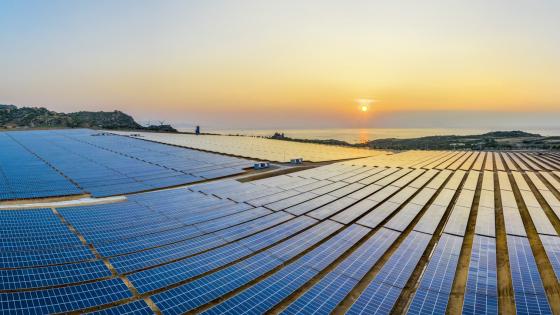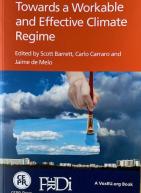The travel shut down in the wake of the spread of Covid-19 will provide but a temporary pause in the rise of global temperatures. Despite pledges by countries to avoid it, the prediction by the Inter-Governmental Panel on Climate Change (IPCC) that average temperatures will rise 1.5 ºC from pre-industrial levels by 2030 will be likely still met (IPCC 2018). By abandoning this cap, the international community has signed the death warrant of low-lying communities between the tropics of Cancer and Capricorn threatened by rising sea levels and more ferocious cyclones.
A 1.5 ºC rise in average temperature will set in train reactions that will impact all, and there is little reason to believe the rise in temperature will stop there. The biggest cause of global warming is the burning of fossil fuels. The switch to renewable energies is necessary for humanity’s future but is currently too slow to save us. Outside hydro-electric power, developing countries most suited – physically and economically – to renewables have generally been slow adopters, sometimes citing the injustice of paying for the sins of the once rapacious and now proselytising.
Beyond important issues of equity, the obstacle to the greater adoption of renewable energies, especially solar, is no longer financial. Five years after ‘Paris’, annual Green Bond issuance has surpassed $250 billion (Ehlers et al. 2020). Asset managers controlling over $1 trillion of assets have declared they are increasing their allocation to investments that work against climate change.
The critical obstacle today is the pricing, ownership, land-use and approval processes renewable projects have to go through. Few reach the other side (REN21 2016: 20). There are thorny political economy issues at work. I propose three regulatory fixes that will bring dividends for sunnier, developing countries, provide more projects for green investors, and some redemption for the rest of humanity.
Anyone born in the tropics will wonder how Germany became one of the largest producers of solar power (International Energy Agency 2020). Frankfurt has an average of 1,662 hours of sunshine a year out of a possible 4,383.1 Compare that with Delhi’s 2,684 hours2 and Bridgetown’s 3,050.3 This is a unRicardian tale of how regulatory policy can turn comparative disadvantage into advantage.
Most countries have economic policies that promote renewables (European Commission 2009). Germany had such policies in place in the 1970s, but renewable energy production rocketed much later. A critical factor is the transmission of policy through the regulatory framework. In Germany, Japan, Spain, and a few other places, the regulatory framework was an accelerator; in many other places, it is a decelerator.
I have come across three main regulatory obstacles facing investment in renewable energy in developing countries. The most interesting is pricing. Enthusiasts like to say that the sun and wind are free. But it is still more expensive to deliver a constant renewable energy load to where it is needed using renewables than fossil fuels when one does not consider the global environmental costs of greenhouse gas emissions – about 10-15% more expensive for solar, more for waste-to-energy and less for wind (Helm 2017).
As we don’t yet have an international system of funding these social externalities, cash-strapped countries cannot wish them away. Ideally, we should lower the relative price of renewables through a Pigouvian tax on fossil fuels and wait for renewable investments to follow. This would directly lead to an unpopular and initially deadweight increase in electricity bills, which would shake the confidence of investors that their new 20-year power purchase agreement will survive political challenge. The second-best solution adopted by most is a subsidy for renewables that is hard for consumers to see. How should it be set?
Economists like the elegance of auctions (Lopez Soto et al. 2019). Let the market determine the support level required to hit a renewable energy target, they say. And not just in Chicago; the bright economists in the renewable energy divisions of multilateral development banks recommend auctions. And because they believe they know best, they pressure countries to adopt auctions using the wide arc of soft power at their disposal.
In Europe, where policymakers are free of that pressure, the early pioneers used a variety of approaches to attract renewables, including auctions. Published ‘feed-in tariffs’ delivered the most rapid investment and lowest costs to consumers (Haas et al. 2011). I think this is because feed-in tariffs provided certainty and validation in new markets where there were not deep conventions, valuation yardsticks, or even contract certainty.
Despite the latest designs, auctions may not, at the beginning at least, provide the optimal result for consumers when there are high upfront capital expenditure, long contracts, and deep uncertainty around critical profitability factors (Butler and Neuhoff 2008). Moreover, the evidence is that auctions require bidders to have the ability to absorb risks and play strategic games (Gsänger 2016, World Wind Energy Association 2016). Many small players stay away. The impact of the regulatory framework on wealth and capital concentration is a critical policy issue in developing countries, where this is often highly skewed (McGee and Greiner 2019).
The challenge with feed-in tariffs (and also for auctions though theoretically less so) is that they lock in for 20 years the premia for uncertainty and risks required to get an investment going, even though within a few years, many of those uncertainties and risks fall away. If the investors knew in year 0 what they would learn by year 3, they would accept a lower feed-in tariff. A solution is for the feed-in tariff to have a predictable and limited variable component directly connected to the reduction in risk and uncertainty.
One example is the innovative feed-in tariff approved by the Fair Trading Commission of Barbados for a large Green Energy Park, where the price automatically falls by 5% every seven years if the external auditors attest that distributions to shareholders exceed a 15% per annum threshold.
There is a long history of challenges with profit and earnings thresholds for regulatory pricing. It incentivises the misclassification of profits and disincentivises investment and cost control. But this is not a unique problem, we come across every day in banking regulation and there are new verification tools. The possibility of a ‘clawback’ may seem unattractive to investors but because it only occurs when their returns have exceeded projections, it is a cheap option to offer consumers in return for a price that compensates for start-up uncertainty and risk.
Feed-in tariffs have proved useful in bringing in new market entrants. But many developing country governments want more. Renewable energy is a rare opportunity to reset the imbalanced ownership of assets and respond to the seductive idea that this is ‘our’ patrimony and it should not be sold to foreigners. But renewable energy investments are capital-intensive, and it is unlikely that a developing country could attract the capital needed if foreign investors are held to a minority position in a foreign land. Furthermore, relying on local capital for large start-up projects would only reinforce the existing skewed ownership of assets. And attempts to broaden local ownership at the start-up would only hoist unproven companies onto unsuspecting retail investors.
One solution is to have a requirement that, after three years of operation, there is an initial public offering (IPO) with a priority allocation to small local investors or their collective investment vehicles like mutual funds and credit unions. By year three, start-up and construction risks would have passed, and the public will have a better measure of the management. Far from considering this a hindrance, early-stage foreign investors may like a pre-determined framework for exit.
The other obstacle to getting renewable energy projects started in developing countries is the approval process. The ministry of agriculture will object to the land being taken out of agriculture – solar farms are very land-intensive. Town and country planning will report that everyone loves windmills and solar panels but only if they are somewhere else. This isn’t irrational ‘not in my back yard’ NIMBYism; the proximity of wind turbines and solar farms reduce the price of homes (Koster and Dröes 2020). The ministry of energy will want to consider the mix of different sources and places of energy production. The Fair Trading Commission will fear that this will conflict with the interests of consumers. And so on.
The sequential aspect of these regulatory hurdles kills off projects and investor enthusiasm. Investors are reluctant to spend money meeting the impact assessments required by one regulator, with the prospect that they could be held up by another. This encourages them to try illegitimate ways or to put in applications that seem speculative or half baked. A modern-day Franz Kafka would be an applicant for a renewable energy licence.
One solution is to turn this sequential process into a parallel one. Everyone who needs to agree need to be in the room simultaneously and perhaps not leave before an approval target has been reached. This college of regulators must speedily respond to applicants with either a yes or a conditional yes if the applicant makes specified changes. The need for such public-sector reform is not new, but it is acutely required in the renewable energy space.
The only way humanity will survive the 21st century is through a massive take up of renewable energies everywhere (Bolton et al. 2020). What stands in the way is often the regulatory framework for investing in renewable energy. Countries should (1) streamline the approval process, (2) broaden the ownership of assets through mandated IPOs and small-investor allocations while supporting big foreign investors in the short-run, and (3) offer an attractive feed-in tariff that predictably ratchets down in favour of consumers once investors reach their return threshold. A more equitable international environment would encourage such local self-help.
Industrialised countries must hold up their end of the bargain at Paris to help fund loss and damages in the developing world caused by climate change.
References
Bolton, P, M Despres, L A Pereira da Silva, F Samama and R Svartzman (2020), “The green swan”, Bank for International Settlements and Bank of France.
Butler, L, and K Neuhoff (2008), “Comparison of feed-in tariff, quota and auction mechanisms to support wind power development”, Renewable Energy 33(8): 1854–67.
Ehlers, T, B Mojon, F Packer and L A Pereira da Silva (2020), “Green bonds and carbon emissions: Exploring the case for a rating system at the firm level”, VoxEU.org, 12 December.
European Commission (2009), Directive on the promotion of the use of energy from renewable sources, 2009/28/EC.
Gsänger, S (2016), “The global trend towards auctions – will it kill decentralized renewable energy?”, WindTech International.
Haas, R, G Resch, C Panzer, S Busch, M Ragwitz and A Held (2011), “Efficiency and effectiveness of promotion systems for electricity generation from renewable energy sources – Lessons from EU countries”, Energy 36(4): 2186–93.
Helm, D (2017), “Cost of energy review: Report”, UK Department for Business, Energy and Industrial Strategy.
International Energy Agency (2020), “PVPS: Snapshot of global PV markets 2020”.
IPCC (Intergovernmental Panel on Climate Change) (2018), “Special Report on Global Warming of 1.5℃”, Incheon, Republic of Korea, 8 October.
Koster, H, and M Dröes (2020), “Wind turbines and solar farms drive down house prices”, voxeu.org, 20 September.
Lopez S, D D, A N Mejdalani, A Nogales, M Tolmasquim and M Carvalho Metanias Hallack (2019), “Advancing the policy design and regulatory framework for renewable energies in Latin America and the Caribbean for grid-scale and distributed generation”, Inter-American Development Bank.
McGee, J A, and P Trent Greiner (2019), “Renewable energy injustice: The socio-environmental implications of renewable energy consumption”, Energy Research and Social Science 56: 101214.
REN21 (2016), “Renewables 2016 global status report”, Renewable Energy Policy Networks for the 21st Century.
World Wind Energy Association (2016), “Abrupt introduction of renewable energy auctions threatening Pakistan’s renewable energy market”.
Endnotes
1 https://www.dwd.de/DE/Home/home_node.html
2 https://www.currentresults.com/Weather/India/annual-sunshine.php#a
3 http://www.barbados.climatemps.com/sunlight.php



